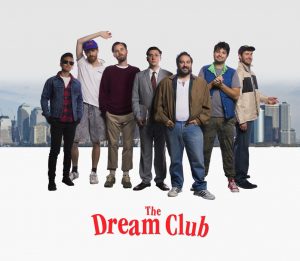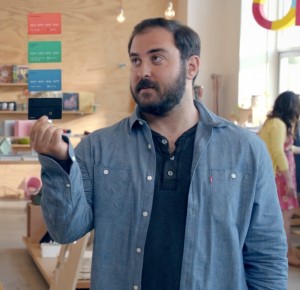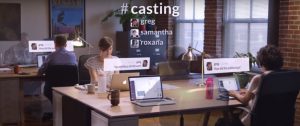Sandwich Video is an accidental video production startup and, incidentally, an accidental startup investor. What started as Adam Lisagor’s pet project to build an app for the iPhone quickly turned into one of the most in-demand video producers for startup companies, when Adam’s short video to promote his app got more views than the app itself. When he started getting emails from “actual” companies (his words) to create their commercials, Sandwich Video came to be.
Now, the Sandwich Video team of around 15 creatives (along with many, many more collaborators contributing over the years) makes magic. And in addition to producing hilarious, unique commercial videos that couldn’t be more “of the moment” if they tried, Sandwich Video also acts as an investor of sorts to some of the companies they work with, by accepting equity in a startup in exchange for their services. More than just looking for new ways of making money, this tactic is a resounding endorsement for these young companies, lending even more cachet to the Sandwich name.
We sat down with Adam, Zach and Jeff to discuss why the business of making commercials seriously needed a refresh, and how visual effects (like those from Red Giant and in Red Giant Universe) can make the new look old again – in the best way possible.
Red Giant: Tell us a little about yourself – what do you do and how did Sandwich Video come to be? How did you get started in video?
Adam Lisagor: I was into video from an early age, from the age of 11, mostly experimenting with how to recreate special effects with our family’s home video camera. After graduating from NYU, I found myself working in visual effects on a studio movie. I learned the whole visual effects industry, and at some point, technology and the Web became more interesting to me, and the mainstream entertainment industry became a little less interesting. At the same time, all these tools were becoming democratized, so you didn’t have to have a multi-million dollar facility in order to do this cool work. You could do it in your bedroom, so I jumped off and started making these small videos on my own. Then when the iPhone App Store came into existence, a friend and I made an app, and I ended up making a little video to promote it using my skills as a video maker and compositing and motion graphics and stuff. That video ended up getting a lot more attention – the app did okay but the video did really well. Then I started getting emails from actual big huge tech companies, to come do videos for them. That’s how Sandwich Video got started.
RG: Sandwich video takes a unique approach to marketing their clients’ products through video. What is your philosophy and approach to creating commercials?
AL: Early on I realized that there was a vacuum of good compelling video for tech tools and tech products. Technology was what I was most fascinated by, so I just employed the philosophy that the best way to introduce a tech product to somebody is to really make them feel as though they were using it for the first time, because a good tech product is … I think it’s Arthur C. Clarke who said, “indistinguishable from magic.”
Sufficiently advanced technology is indistinguishable from magic, so you want to make people feel like they’re experiencing magic when they’re introduced to the product using video. And I just didn’t see that happening very much in the demo, promo, commercial video space, so that was the main ambition of doing what we do.
It turns out that post-production and visual effects play a large part of that because, when I started this company seven years ago, people were already accustomed to video being pretty prevalent, but what wasn’t so prevalent was interesting visual effects and interesting digital visualizations done tastefully, in ways that help enhance your understanding of what’s being shown.
Philosophically, I guess what that says is that we rely on these sets of tools, like Red Giant, at our disposal for enhancing and augmenting the viewers’ understanding of the ideas we’re trying to get across. The tools don’t get in the way if they’re doing their job. They are only increasing the value of what you’re making.
RG: How do you ensure each spot is totally unique to the product / service / startup you’re working with?
AL: That’s a great question. Originality and uniqueness is one of the core values at Sandwich. If we ever start to feel like what we’re doing has been done a lot either by us, because we’ve made more than a few hundred videos at this point, or by some other company or brand, then we try to think our way out of that problem. Not because novelty is the key, not because in order to be interesting, something has to be new, but because every product is its own character. What makes characters compelling is the same as what makes people compelling,
it’s what makes them different from each other. In that sense, we try to imbue every project with some amount of character that makes it stand on its own.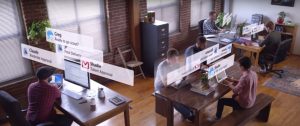
RG: How did you discover Red Giant and how long have you been using Red Giant plug-ins? What specific tools do you use / are your favorites or do you find the most useful?
AL: I think when I first became aware of Red Giant is when Magic Bullet was still sort of new. I just remember thinking, because I come from a visual effects background, you’re used to building your own toolset from scratch to solve a lot of problems and granularly building up what it is you need to do. There’s a lot of intricate detail work in that, and then knowing the basics of something like color correction. When I saw a professional-grade tool that could still somehow introduce the basic concept of color correction and color grading or looks to a new hobbyist or prosumer video maker, I find that’s very interesting and compelling.
In the same way that when Instagram came along and all of a sudden it made it really easy to put all these filters on your photos, it was basically doing the job of educating the public about this idea that you don’t just put out exactly what raw material your camera creates. You can treat it a little bit, process it in post to make it look better. I think that that’s been one of the greatest values of Red Giant, is figuring out the best democratic versions of these tools, and giving that superpower to a lot of filmmakers to make their stuff better.
Jeff Hodges: Going along the lines of what Adam was saying about using VFX and graphics to help tell a story and explain things in the Sandwich style, a lot of what we end up doing is integrating our motion graphics into the scenes so they feel like they really belong there.
That involves a lot of roto and green screen keying. Honestly, we use the Key Correct Suite a whole lot, in pulling those masks and in improving our composites. I would say honestly we probably use the Keying Suite more than anything else from Red Giant.
RG: What is the typical timeline from idea to final video, and how do the Red Giant tools you use help you deliver under a tight deadline?
AL: The typical timeline for any given project at Sandwich is between two and three months. Generally, we’ll be in creative/pre-production for about a month to six weeks. Then we’ll shoot for a day or two, or three or four, and then we’ll be in post-production for the rest of that time. Usually about a month is enough time for post-production for us.
Overall, we’re usually between 15 and 20 projects going on at the same time, each in a different phase, with our phases being creative, production and post. Usually at any given time, we’ve got five to seven projects in post. We like to tailor each individual artist to the project. We try to work with, I would say ideally, a wider variety of people than what we just have on staff. We like to mix it up.
When it comes to using Red Giant tools on these projects, we’re offering a familiar toolset to anybody who comes through the door. If they have worked with the tools before, with someone else or on their own projects, then having the toolset available to them probably maximizes our efficiency with that particular effect. 75 to 80-percent of our output is touched by Red Giant tools in one way, shape or form.
RG: How have Red Giant tools helped you achieve a precise look for a project you were working on?
AL: Close to two years ago, we started making this web series called “Computer Show.” The concept is that it’s a technology talk show set in 1983. The guests on this talk show are all modern-day tech founders that were there to come on the show to explain the tech projects that they’re working on. Tech founders from 2017.
To sell that joke well, the gag has to be very obvious; the characters have to be very period-accurate, from the look of the set to the wardrobe to the hair, the dialogue, the way that the characters talk, the music, the motion graphics, everything. It has to be very, very authentic
or the joke doesn’t work at all.
We’ve seen plenty of bad 80s stuff, as in, unintentionally inaccurate to period. That was a norm for as long as people have been trying to recreate the 80s. That’s annoying to begin with, but it’s even more annoying if you grew up in the 80s and you know what the stuff is supposed to look and feel like. It just takes you out of it.
We shoot Computer Show using Panasonic HVX cameras, so we have a little bit more control over the frame rate. But we don’t want it to look like digital cinema so after they color graded it, we ran it through a post process to make it look like it’s all being archived on video to a magnetic video tape from the era, and then dug out of a crate somewhere in some abandoned TV studio.
We went out and bought a three-quarters inch U-matic video deck with these giant video tapes. They are antiquated technology. They look like a specific kind of (expletive), and that was the look that we were going for. When we finally got it all hooked up and working – and it was fun for me to see these younger guys try to figure out that ancient technology because it’s not at all native to them – what we found was that yes, we got it working and we could lay it out to three-quarters inch tape, but we didn’t have enough control to create the amount of
crappiness we needed.
We wanted the magnetic tracking wave to come down the frame. We experimented with whacking the side of the deck to make it happen, and that just doesn’t seem like a very good or a technically accurate way of doing this, making this happen, but I knew that I’d seen some of this stuff that looked really, really authentically 80s.
Then our editor at the time for the show told us about this plug-in that Red Giant makes, and I think it was fairly new at the time. At that point, we had even tried a banging up a VHS deck, but it just didn’t have the right look. We ended up trying out Universe. It was exactly the perfect thing. We dialed in all the settings perfectly, and I couldn’t be happier with the look of it. Now anytime I see anything that uses Universe, I know that they are using Universe because it looks so authentic.
RG: So, what exactly is the Sandwich Dream Team?
AL: When Seth Worley asked if they could send a photographer out to shoot a portrait of us, I wanted to put the Sandwich Video stamp on it. And since the Red Giant tool we use most prominently is Universe, we thought maybe it would be fun to do something around the 80s, bring that visual aesthetic to it somehow. Being a child of the 80s and remembering those 80s movie posters, that ends up informing a lot of your excitement of movie-going and cinema in general.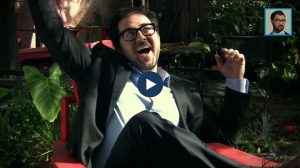
When I thought about a group of people, like a rag tag group of people coming together to make something, I thought of the movie The Dream Team, which I had seen in the movie theater when I was a kid, with Michael Keaton. It’s so wacky and it just fits perfectly into that genre. The seven of us each picked our characters. I got to be Michael Keaton. I’ve never been happier. Then we all did our own thrift store shopping and picked out our wardrobes – it was
really a fun experience for us. Then Zach Hobesh comped the cityscape background on it. The Dream Team was pretty tongue-in- cheek; we’re mostly referencing a rag tag crew of weirdos that all get to work together.
Any final words?
AL: No. Just that software is such an important part of our process, not only because we’re using software in our work but we tell stories about software. It’s really nice to have the support of a company that’s been around making these really influential tools for so long, and also to be friends with them.

